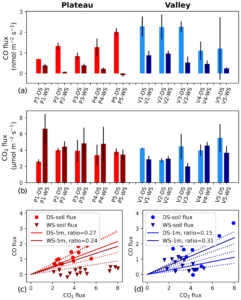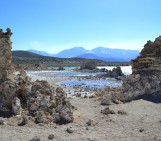
When I was thirteen years old, my family and I almost lost our lives due to a carbon monoxide (CO) leak. I never stopped thinking about that incident even though it happened over twenty years ago. Not only because it was a premature realisation of my own mortality, but also because of how sneaky it was: We did not smell it, see it, hear it, or feel it. It was a subtle and slow killer that could have claimed our lives in our sleep. So when I read Hella van Asperen and their team’s paper, published in EGU’s Open Access journal Biogeosciences, it immediately brought back the anxiety I once felt about the threat of carbon monoxide, but this time, it’s not a water heater… it’s our soils!
Carbon monoxide (CO), a toxic, but naturally occurring gas emitted by both living organisms and decaying plant matter in the soil, as well as from the soil itself, has primarily been studied in temperate and boreal forests. These forests typically act as a net sink, absorbing more monoxide than they release. But what about tropical rainforests? In the natural world, we don’t fully understand where carbon monoxide comes from and where it goes. Soil can either release CO into the air or absorb it. For the first time, scientists have measured direct carbon monoxide emissions from tropical rainforest soils, and their research reveals that the so-called ‘lungs of our planet’ are actually exhaling significant amounts of carbon monoxide.
The absorption of carbon monoxide in soils primarily occurs through processes involving bacteria or enzymes that break it down into other chemicals, as well as the decomposition of organic matter either by sunlight, heat, or during the senescence of plants. Temperature does not significantly affect the amount of carbon monoxide absorbed by soil, but it does influence the movement of gases through the soil matrix.
The behaviour of carbon monoxide in tropical forest soils has been a subject of debate, with conflicting models suggesting varying emissions rates. Some models propose significant emissions, while others suggest these soils might absorb more carbon monoxide than they release. To address this uncertainty, Hella van Asperen and their team conducted a study in the mature rainforest of Reserva Biológica do Cuieiras, located approximately 50 km northwest of Manaus, Brazil. This area features diverse landscapes including plateaus, steep slopes, and valleys.
At the base of the micro-meteorological K34 tower, the researchers employed a Fourier Transform Infrared (FTIR) analyzer to measure various greenhouse gases such as CO2 and CH4, along with their isotopes. They also collected carbon monoxide data from nearby valleys and on a plateau.
What matters more, seasons or topography?
The amount of carbon monoxide that soil absorbs versus releases depends on various factors such as soil moisture levels, carbon content, land type, and nutrient availability. These factors undergo daily and seasonal changes, which affect the balance between absorption and release. For example, soil typically absorbs carbon monoxide at night but releases it during the day. Over longer timeframes, soil tends to absorb more carbon monoxide in colder seasons and release more during warmer periods.
We can state that tropical rainforest ecosystems are likely a net source of CO, and we expect that soil emissions are the main contributor to the ecosystem CO emissions.
Their findings show that, overall, soils in tropical rainforests in the Amazon actually release more CO than they take in. By studying different parts of the rainforest during different seasons, the authors tried to understand more about where CO comes from in this ecosystem. They found that carbon monoxide release varied significantly with seasons and specific locations. The highest releases occurred during dry seasons and in low-lying areas that flood seasonally and that temperature played a crucial role; higher temperatures in both locations resulted in more CO being released from the soil. The did find however that the soil was the important contributor to carbon monoxide release, not the plants as leaves and other plant materials released significantly less CO compared to the soil itself.

The graphs in this image show (a, b) CO and CO2 soil fluxes at five different locations on the plateau (left, red colours) and in the valley (right, blue colours). Lighter colours indicate dry season (DS), and darker colours indicate wet season (WS).
By conducting intensive soil flux measurements they found that carbon monoxide fluxes on the plateau were higher during the dry season compared to the wet season, with similar patterns observed in valleys. On the plateau, soil temperature was positively correlated with CO fluxes, while valley CO fluxes showed weaker correlations with temperature and moisture.
Although atmospheric carbon monoxide mixing ratios varied seasonally, this was also correlated to other factors as the data showed increased variability and peaks during the dry season due to biomass burning plumes. Laboratory results confirmed higher CO emissions from senescent leaves and soils on the plateau compared to the valley, reflecting differences in vegetation and environmental conditions. Tropical rainforests appear thus to be a source of carbon monoxide primarily due to the soil’s response to heat. When these findings are scaled globally, tropical rainforest soils might be releasing approximately 16 teragrams of CO every year; a substantial amount, but this estimate could be even higher if we include monoxide emissions from streams and flooded areas.
Now what?
Reference: van Asperen, H., et al: The emission of CO from tropical rainforest soils, Biogeosciences, 21, 3183–3199, 2024.



